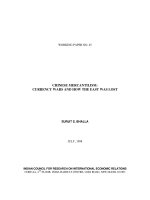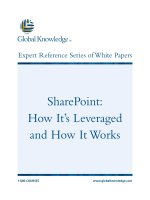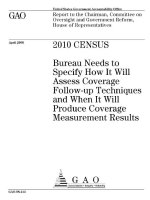The Productivity Revolution and How It Will Ignite the Economy
Bạn đang xem bản rút gọn của tài liệu. Xem và tải ngay bản đầy đủ của tài liệu tại đây (4.89 MB, 434 trang )
TLFeBOOK
DIGITAL
DEFLATION
The Productivity
Revolution and How It
Will Ignite the Economy
GRAHAM Y. TANAKA
McGraw-Hill
New York Chicago San Francisco
Lisbon London Madrid Mexico City
Milan New Delhi San Juan Seoul
3183_U00.qxd 8/7/03 3:07 PM Page i
TLFeBOOK
Copyright © 2004 by Graham Y. Tanaka. All rights reserved. Manufactured in the United States of
America. Except as permitted under the United States Copyright Act of 1976, no part of this publication
may be reproduced or distributed in any form or by any means, or stored in a database or retrieval
system, without the prior written permission of the publisher.
0-07-138967-9
The material in this eBook also appears in the print version of this title: 0-07-137617-8.
All trademarks are trademarks of their respective owners. Rather than put a trademark symbol after
every occurrence of a trademarked name, we use names in an editorial fashion only, and to the benefit
of the trademark owner, with no intention of infringement of the trademark. Where such designations
appear in this book, they have been printed with initial caps.
McGraw-Hill eBooks are available at special quantity discounts to use as premiums and sales pro-
motions, or for use in corporate training programs. For more information, please contact George
Hoare, Special Sales, at or (212) 904-4069.
TERMS OF USE
This is a copyrighted work and The McGraw-Hill Companies, Inc. (“McGraw-Hill”) and its licensors
reserve all rights in and to the work. Use of this work is subject to these terms. Except as permitted
under the Copyright Act of 1976 and the right to store and retrieve one copy of the work, you may not
decompile, disassemble, reverse engineer, reproduce, modify, create derivative works based upon,
transmit, distribute, disseminate, sell, publish or sublicense the work or any part of it without
McGraw-Hill’s prior consent. You may use the work for your own noncommercial and personal use;
any other use of the work is strictly prohibited. Your right to use the work may be terminated if you
fail to comply with these terms.
THE WORK IS PROVIDED “AS IS”. McGRAW-HILL AND ITS LICENSORS MAKE NO GUAR-
ANTEES OR WARRANTIES AS TO THE ACCURACY, ADEQUACY OR COMPLETENESS OF
OR RESULTS TO BE OBTAINED FROM USING THE WORK, INCLUDING ANY INFORMA-
TION THAT CAN BE ACCESSED THROUGH THE WORK VIA HYPERLINK OR OTHERWISE,
AND EXPRESSLY DISCLAIM ANY WARRANTY, EXPRESS OR IMPLIED, INCLUDING BUT
NOT LIMITED TO IMPLIED WARRANTIES OF MERCHANTABILITY OR FITNESS FOR A
PARTICULAR PURPOSE. McGraw-Hill and its licensors do not warrant or guarantee that the func-
tions contained in the work will meet your requirements or that its operation will be uninterrupted or
error free. Neither McGraw-Hill nor its licensors shall be liable to you or anyone else for any inac-
curacy, error or omission, regardless of cause, in the work or for any damages resulting therefrom.
McGraw-Hill has no responsibility for the content of any information accessed through the work.
Under no circumstances shall McGraw-Hill and/or its licensors be liable for any indirect, incidental,
special, punitive, consequential or similar damages that result from the use of or inability to use the
work, even if any of them has been advised of the possibility of such damages. This limitation of lia-
bility shall apply to any claim or cause whatsoever whether such claim or cause arises in contract, tort
or otherwise.
DOI: 10.1036/0071389679
ebook_copyright 6x9.qxd 10/20/03 11:23 AM Page 1
TLFeBOOK
Want to learn more?
We hope you enjoy this McGraw-Hill eBook! If you d like
more information about this book, its author, or related books
and websites, please click her
e.
DOI Page 6x9 10/2/02 1:33 PM Page 1
,
TLFeBOOK
DEDICATION
This book is dedicated to my mom, Yuri, and in memory of my dad,
Yasuo Clifford, who always encouraged me to do my best and who
gave me the guidance and education to achieve my goals. I would
also like to dedicate this book to my wife, Molly, and my kids, Spencer
and Russell, who were patient and accommodating on those count-
less weekends and evenings I spent researching and writing Digital
Deflation.
3183_U00.qxd 8/7/03 3:07 PM Page iii
TLFeBOOK
CONTENTS
Preface xii
Introduction xiv
CHAPTER 1
MYSTERIES, PUZZLES, AND PARADOXES OF THE NEW
ECONOMY 1
The New Economy of the 1990s 1
Was the New Economy of the 1990s Real? 3
Why Were the 1990s So Great? 5
Is There Too Much Optimism or Too Much Pessimism? 7
Are We Heading for Deflation Like Japan in the ’90s or the U.S. in the ’30s? 9
Can the Future Be What It Used to Be? 10
CHAPTER 2
SOLVING THE MYSTERY: MISSING PRODUCTIVITY AND
THE GREAT INFLATION MISMEASURE 11
Demographics: Baby Boomers, Working Women, and the Super
Bull Market 11
Three Hits and a Miss 15
Where’s the Missing Productivity? 15
The Boskin Reports on the CPI 19
“Faster, Better, Cheaper”—The Parable of the Pink Caddy 21
The Intel–Microsoft Double Helix and John the Barber’s PC 23
The Consumer Knows Best 24
How the Government Counts Quality Improvement 26
Solving the Mystery of the New Economy 28
CHAPTER 3
THE THEORY OF DIGITAL DEFLATION: FASTER, BETTER,
CHEAPER 31
Digital Deflation Is a Good Thing 31
Digital Deflation Defined 32
The Digital Drivers 35
iv
3183_U00.qxd 8/7/03 5:29 PM Page iv
For more information about this title, click here.
Copyright 2004 by Graham Y. Tanaka. Click Here for Terms of U se.
TLFeBOOK
The “Next Big Thing” 39
Is the Digital Revolution Better Than the Industrial Revolution? 40
The Laws of Digital Deflation 41
How Big Is Digital Deflation? 43
What’s Missing from the GDP Deflator? 47
The Lost Components 49
CHAPTER 4
WHY THE OLD MODELS DIDN’T WORK IN THE 1970s
AND 1980s 53
Economic Models Work Best in Times of Stability and Few Surprises 53
The 1950s and 1960s: Existing Economic Models Worked Well 54
The Late 1960s/Early 1970s: Models Break Down with the Rise
in Inflation 55
Internal Disruption from Wage-Price Controls 56
External Disruption from OPEC Oil Price Increases 59
The Late 1970s: Hyperinflation 59
The Demise of the Keynesian Dynasty 60
Monetarism Takes the Lead 60
The 1980s: Volcker to the Rescue 62
The Early 1980s: Enter the Supply-Siders 64
The Late 1980s: Market Price Rule Predictors 67
Demographics—Why the Traditional Models Didn’t Work 69
Demographic Forces Turn Positive in the 1980s and 1990s 71
CHAPTER 5
WHY ECONOMISTS HAVE DIFFICULTY EXPLAINING THE
NEW ECONOMY 74
The Amazing 1990s—Strong Growth and Low Inflation 74
Information Technology, Productivity, and the New Economy 77
Overstated Inflation and Undermeasured Productivity 78
Was the Internet Driving the New Economy? 80
Digital Deflation—Why the Old Models Didn’t Work in the 1990s 80
Productivity from Digital Deflation Is About Quality, Not Quantity 83
What the Government Didn’t See… 86
…Consumers and Investors Could See 87
The Year 2000 Lockdown 88
The Wealth Effect—A Rising New Force in the New Economy 92
v
CONTENTS
3183_U00.qxd 8/7/03 3:07 PM Page v
TLFeBOOK
Is There a Corporate Wealth Effect? 95
Investor-Consumers 95
New Models Needed 96
CHAPTER 6
REDEFINING THE NEW ECONOMY 98
New Forces in the New Economy 98
What Is the New Economy? 99
Digital Deflation Redefines the New Economy 100
Old Economy Companies in the New Economy 103
The Importance of R&D 106
The Old Economy Will Lose Share and Profits to the New Economy 107
How the New Economy Lifts Productivity 108
Structural Productivity Gains 109
When Did the Government Start to Measure Digital Deflation? 110
How Did Computer Quality Improvement Boost Productivity in the
Late 1990s? 112
Massive Implications for Productivity Across the Economy 114
Software Quality Improvements Are Elusive but Real 115
Communication Services Are Getting Faster, Better, Cheaper 117
The Huge Healthcare Quality Mismeasure 119
The Service Sector Is Grossly Undermeasured 120
The Service Sector Supply Chain 122
Solving the Mystery of Rising Capital Spending and Declining
Productivity 124
The “Productivity Revolution” Is Under Way 126
Disaggregation into the New Economy and the Old Economy 128
CHAPTER 7
NEW MODELS FOR THE NEW ECONOMY 129
Better Models, Better Forecasting 129
I. DEMOGRAPHIC MODELS 130
A Demographic Foundation for the New Economy 130
The Demographic–Inflation Model 131
The Demographic–Stock Market Model 135
The Demographic–Productivity Model 135
Demographic–Productivity Model Adjusted for Unmeasured
Digital Deflation 136
vi
CONTENTS
3183_U00.qxd 8/7/03 3:07 PM Page vi
TLFeBOOK
Demographic–GDP Models 137
The Stock Market and Real GDP 137
The Stock Market and Corporate Profits 139
“Potential Productivity” 139
II. PRODUCTIVITY MODELS 140
The Capital Spending–Productivity Model Revisited 140
How Long Has the Government Undermeasured Productivity? 142
Productivity and Profit Margin Model 143
The 120% Profit–Productivity Rule of Thumb 145
The Over 3.0% Productivity Growth Rule 146
The New Economy Productivity–Profit Enigma 146
Are Quality Gains Empty Calories? 148
The Fed’s Productivity and Capital Decomposition Model 151
New Models for Predicting Information Technology’s Contribution to
GDP and Productivity 153
III. DIGITAL DEFLATION MODELS 156
Estimating the Undermeasurement of Digital Deflation 157
The “GDP Deflator-Digital Deflation” Model 159
Computer and Semiconductor Digital Deflation “Lost” As Intermediate
Goods 161
IT Industries Not Yet Measured for Quality Improvement, Including
Computer Services, Software, and Communications 163
Non-IT Industries Not Yet Measured for Quality Improvement, Including
Healthcare, Financial Services, and the Military 167
The Quality Improvement Quotient 172
The “CPI-Digital Deflation” Model 173
IV. WEALTH MODELS 177
Household Tangible and Net Financial Assets 177
The Wealth Effect 181
The Consumer Wealth Effect 181
The Realized Capital Gains Wealth Effect 185
The Corporate Wealth Effect 186
CHAPTER 8
THE WEALTH IN OUR FUTURE 191
The 2020 Vision 191
A Wide Range of Possible Outcomes 193
vii
CONTENTS
3183_U00.qxd 8/7/03 3:07 PM Page vii
TLFeBOOK
Value Created from Digitally Driven Quality Improvement 194
Two More Decades of Value Creation 196
Value to Wealth: The New Economy’s Virtuous Circle 198
Measuring Wealth 200
Adjusting Wealth for Digital Deflation 202
A Strong Demographic Foundation for Generating Wealth 203
The Digital Deflation Wealth Multipliers 206
The Key to Wealth Is Low Inflation 207
A “Near Zero Experience” 208
Picturing Zero Inflation Will Be Difficult for Many 209
The GDP Deflator Adjusted for Digital Deflation 210
The CPI Adjusted for Digital Deflation 212
Why the CPI and GDP Deflator Will Diverge 213
Which Is the Right Inflation Rate? 214
Four Scenarios for the Wealth In Our Future 215
Fair Value P/E’s and Wealth 217
CHAPTER 9
THE NEW ECONOMY STOCK MARKET 218
The Importance of Equities 218
A “New Economy Stock Market Model” 219
Inflation, Interest Rates, and Fair Value P/E’s 224
P/E Ratio Forecasts for the Next Two Decades 228
Higher Productivity and Profit Margins in the Next Two Decades 229
New Economy Stock Market Projections 236
Two More Decades of Wealth Creation 236
A New Economy Wealth Model 239
Growth in Equity-Like Assets 240
How Digital Deflation Helps Homeowners Build Wealth 242
Digital Deflation Helps Tangible Assets by Driving Interest Rates
Lower 243
The Enormous Upside Potential for Wealth Creation in the
United States 244
On the Upside 245
On the Downside 247
Most Likely Scenario 248
The Surprising Importance of the Real Bond Rate 248
Stocks, Wealth, and the New Economy 252
viii
CONTENTS
3183_U00.qxd 8/7/03 3:07 PM Page viii
TLFeBOOK
CHAPTER 10
MONETARY POLICY: NEW “SPEED LIMITS”
FOR THE FED 255
The Fed’s Challenge 255
A Tale of Two Economies 256
Avoiding a Repeat of the 1920s and 1930s 260
Learning from the 1920s and 1930s 265
Counting Quality Improvement Will Make the Fed’s Job Easier 266
New Speed Limits for the Fed 268
Running Out of Room at the Fed 273
Lessons from Japan’s Deflationary Slump 275
Productivity Gains in a Deflationary Economy 278
The Past and Future Fed 281
CHAPTER 11
FISCAL POLICY AND BETTER DATA IN A DIGITALLY
DEFLATING WORLD 283
Wealth and Poverty in the New Economy 283
Wage Earners Will Earn More 286
The New Economy, Unemployment, and Crime 288
The “Politics Of Need” 290
Better Data for the New Economy 292
The New Economy and Budget Surpluses 294
The Dark Side of Demographics 295
CHAPTER 12
WISE INVESTING IN THE NEW ECONOMY 299
Real-World Investing 299
Real-World Results 301
Did the Internet Boom Spike the Punch? 304
Investing Wisely in the New Economy 306
Pointers for Investing in a Resurging New Economy 307
The Prelude to a New Era of Prosperity 312
ix
CONTENTS
3183_U00.qxd 8/7/03 3:07 PM Page ix
TLFeBOOK
x
CHAPTER 13
DIGITAL DEMOCRACY: GLOBALIZATION OF THE NEW
ECONOMY 315
New Economy Entrepreneurship 315
Digital Democracy 316
Counting Digital Deflation and Productivity Properly 319
Japan and China Can Create Enormous Wealth 320
Europe Must Recognize Digital Deflation to Optimize It 322
Cowboy Capitalism and Wealth Creation 326
The Soviet Experiment 327
Digital Deflation and the Dollar 328
Global Prosperity Will Lift All Boats 330
CHAPTER 14
THREATS AND OPPORTUNITIES: MAKING THE WORLD A
BETTER PLACE 331
Making the Digital Revolution Better Than the Industrial Revolution 331
The Politics of Better Data 333
Fixing the Third Rail 335
Better Healthcare from Better Data 338
Moving Faster with the Fed 339
How Much Does the Fed Know? 340
One Foot on the Brakes and One Foot on the Gas 343
Capital, Labor, and Technology 344
Managing Booms and Bubbles 346
Quality Improvement and Degradation 347
Making the World a Better Place 348
EPILOGUE
CLOSER TO DEFLATION THAN YOU THINK 355
FIRESIDE CHAT INTERVIEWS WITH CREATORS OF DIGITAL
DEFLATION 357
Interview with Gordon Moore (Intel) 357
Interview with Richard S. Hill (Novellus) 363
Interview with Doug J. Dunn (ASML Holding N.V.) 367
Interview with Michael Dell (Dell, Inc.) 374
CONTENTS
3183_U00.qxd 8/7/03 3:07 PM Page x
TLFeBOOK
Interview with Irwin Jacobs 376
Interview with Stephen Fodor 381
APPENDIX A: Tanaka Capital Management
P/E Conversion Table 392
APPENDIX B: Household Tangible, Net Financial, and Equity-
Like Assets as Percentage of Net Worth 393
APPENDIX C: Decades of Growth in Equity-Like Assets 394
APPENDIX D: Wealth Model Using 3.00% Real Rate 395
References 396
Index 407
Acknowledgements 417
xi
CONTENTS
3183_U00.qxd 8/7/03 3:07 PM Page xi
TLFeBOOK
PREFACE
INVESTING IN THE NEW MILLENNIUM
This book reveals the fundamental drivers of the New Economy in the
1990s and sets the stage for a clearer understanding of the economic
and investment environment of the next 10–20 years. By introducing
some new theories and by challenging or tweaking some old ones,
readers will be shown how to make some sense out of these confusing
times. When the “good times” were happening, there was perhaps
less urgency to understand exactly why they were happening. Now
there is a greater need to know, and real answers will be offered. Per-
haps even more importantly, it will be shown how rapidly advancing
technologies may create economic conditions over the next two
decades that could be almost as favorable as the 1990s—if appropriate
fiscal and monetary policies are pursued. Investors will learn what to
watch for so that they can make important adjustments to their port-
folios based on whether the proper policy decisions are made during
the next few years.
Many of the inflation, interest rate, and stock market theories
presented in this book are brand new to the public. As most of the sce-
narios described are long term in nature, they should be particularly
helpful for investors faced with the daunting task of planning for their
retirement over the next ten to twenty years. After the sharp stock
market downturn in the first few years of the new millennium, some
investors are questioning the value of investing in common stocks.
Anxiety levels may remain high due to the absence of clear explana-
tions for how the New Economy of the 1990s arrived so mysteriously,
setting records for growth and creating prosperity, only to suddenly
disappear.
The process for developing the Theory of Digital Deflation
started with unrelated theories on Demographics and productivity
well before anyone was talking about the New Economy. As luck
would have it, however, these theories established an absolutely criti-
cal foundation for researching and understanding Digital Deflation
and how it uniquely drives the New Economy. With the benefit of
growing Digital Deflation over the next two decades, the U.S. econ-
omy can attain higher growth without inflation, creating proportion-
ately more real value and vastly more wealth than ever in the history
of mankind.
xii
3183_U00.qxd 8/7/03 3:07 PM Page xii
Copyright 2004 by Graham Y. Tanaka. Click Here for Terms of U se.
TLFeBOOK
xiii
PREFACE
There will be threats and challenges to overcome. Our fiscal and
monetary policymakers will need to open their minds to using new
theories and models to set the appropriate policies for the New Econ-
omy. Investors and corporate managers will have to learn new tricks
to win in a brave new world where some rules will change and some
won’t, but most assuredly, the New Economy will take share from the
Old. It is hoped that this book will help all investors, large and small,
as we may possibly be standing at the doorstep of the next multi-year
bull market.
Graham Y. Tanaka
3183_U00.qxd 8/7/03 3:07 PM Page xiii
TLFeBOOK
INTRODUCTION
I have organized the book into four chapter groupings plus the
“Fireside Chat” interviews section, so readers can read the book at his
or her own pace. The first three chapters present the basic concept of
Digital Deflation and how I realized its existence.
The second grouping, Chapters 4 through 7, reviews why econo-
mists have had so much trouble predicting the economy using the Old
Economic models. New theories and models are offered to help ex-
plain what really drove the “New Economy” of the 1990s.
Chapters 8 and 9 describe why many of the favorable forces that
fueled the ’90s are poised to return—and how the stock market can
generate significant wealth for investors over the next one to two
decades.
The last five chapters (Chapters 10–14) discuss the key implica-
tions for a future world of increasing Digital Deflation, starting with
all-important monetary policy in Chapter 10 and fiscal policy in
Chapter 11. There is a chapter dedicated to investors, a chapter pro-
viding a global perspective, and one that highlights the threats and
opportunities ahead.
Finally, there is a collection of informal interviews with leading
lights of the Digital Revolution. They provide personal insights on
the unique contributions of their advancing technologies to our econ-
omy, in the past, as well as for the next several years.
xiv
3183_U00.qxd 8/7/03 3:07 PM Page xiv
Copyright 2004 by Graham Y. Tanaka. Click Here for Terms of U se.
TLFeBOOK
1 CHAPTER
1
Mysteries, Puzzles, and
Paradoxes of the New
Economy
The trouble with our times is that the future is not what it used to be.
Paul Valery (1871–1945)
What drove the U.S. economy in the 1990s, and will those same conditions
ever be seen again? How did the U.S. economy set a record for the longest ex-
pansion ever, while at the same time, surprisingly, the rate of inflation de-
clined in half? Why did productivity gains suddenly accelerate in the late
1990s after decades of disappointment? Despite the economic downturn and
the stock market’s sharp declines in the early 2000s, the achievements of the
New Economy of the 1990s were very real. Is there any chance that they will
reemerge any time soon? Or are we at risk of suffering the kind of deflation-
ary slump that Japan experienced in the 1990s, or the U.S. itself experienced
in the 1930s? Conversely, could we face a return to the hyperinflation, stag-
nation, and budget deficits of the 1970s and early 1980s?
THE NEW ECONOMY OF THE 1990s
Even now, with the benefit of a few years of historical perspective, the
American economy of the 1990s remains full of mysteries, puzzles,
and paradoxes.
How could the U.S. economy expand so vigorously for a record
10 years, while at the same time, inflation and interest rates declined
in half to 40-year lows? These concurrent trends flew in the face of de-
3183_U01.qxd 8/7/03 3:08 PM Page 1
Copyright 2004 by Graham Y. Tanaka. Click Here for Terms of U se.
TLFeBOOK
2
CHAPTER 1
cades of economic experience and thought, which held that sooner or
later, more dollars and a strong gross domestic product (GDP) had to
translate into more inflation. And how could the unemployment rate
move to record lows without reigniting inflation? Real wages did rise
for the first time since the early 1970s, but somehow, that didn’t seem
to result in higher prices from so-called cost-push inflation.
If the decline in inflation in the 1990s was related to labor pro-
ductivity gains, why did it take until the late 1990s for growth in
productivity to move up after two and one-half decades of disap-
pointment? Inflation, in fact, had already started to decline a full 15
years before the rise in productivity gains in the late 1990s.
The American consumer of the 1990s was also a puzzle. We
know that consumers are rational, they are careful when it comes to
spending, and they can be quick to lose faith in a shaky economy. So
why did they appear to spend beyond their means through the late
1990s? And why did they then maintain their confidence and continue
to spend well into the Post ’90s era of economic slowdown, recession,
extensive layoffs, and stock market declines?
The corporate sector staged its own mystery in the 1990s. Com-
panies were able to rebuild their profit margins and grow their earn-
ings vigorously. How could they do this despite fierce global
competition and the lack of pricing flexibility domestically? Many in-
vestors are curious to know when, if ever, corporate earnings will get
back to prior peak levels.
As for the stock market, investors continue to struggle over what
part of the 1990s was real. How could the U.S. stock and bond markets
move to such lofty levels in the face of high real interest rates? What
then really caused the Post ’90s stock market collapse? Most impor-
tantly, what are the market’s prospects for the future?
As the New Economy took hold during the decade of the 1990s,
even our governments pleasantly surprised us—for a while. Federal,
state, and local budget deficits suddenly became surpluses only to
disappear just as suddenly in the Post ’90s economic slowdown. To
what extent were these budget surpluses related to the New Econ-
omy, and will we ever see surpluses again?
There were also global anomalies in the 1990s. The U.S. economy
grew much faster than the “rest of the world.” Yet, inflation in the
United States plunged to levels well below those of most other indus-
trialized countries. Is this why American households enjoyed a signif-
icantly greater surge in wealth than households in other countries?
3183_U01.qxd 8/7/03 3:08 PM Page 2
TLFeBOOK
3
Mysteries, Puzzles, and Paradoxes of the New Economy
Were these trends enough to explain why the dollar was so strong in
that decade, despite a dramatic expansion in the U.S. trade deficit?
While many attribute the strong economic growth and the vast
creation of wealth in the 1990s to something called a New Economy,
economists have had difficulty agreeing on a definition of this New
Economy and on what created it in the first place. If the New Econ-
omy was the result of a surge in capital spending on information tech-
nology (IT), why didn’t it show up earlier—in the 1970s or 1980s, for
example, when IT spending grew even more vigorously in percentage
terms than in the 1990s? Was it because IT spending reached some sort
of critical mass, with IT capital spending rising to more than 4% of
GDP and “IT-producing industries” rising to almost 8% of the econ-
omy by the end of the 1990s? Or was the New Economy merely the re-
sult of a temporary, late-decade surge in spending to combat the
dreaded Y2K millennium bug?
Some have suggested that it was the Internet and the dot-com
phenomenon that powered the New Economy of the late 1990s. If that
was the case, does the bursting of the Dot-com Bubble mean that
we’ve seen the end of the New Economy?
Looking ahead over the next decade or two, many investors, cor-
porate managers, and policymakers are anxious to know what the
prospects are for the economy and the stock market. They want to
know whether the “good times” of the New Economy of the 1990s can
return in the foreseeable future.
Some pessimists are predicting a replay of the 1970s, character-
ized by sluggish growth, high inflation, high interest rates and lower
price–earnings (P/E) ratios on common stocks. Optimists, on the
other hand, point to record low inflation, low interest rates, strong
growth in labor productivity, and continuing innovation in technol-
ogy, healthcare, and other fields, suggesting better times ahead. So
which will it be?
This book will attempt to answer these and other questions, with
a particular emphasis on looking forward. First, we need to validate
that there was a New Economy in the 1990s before we can understand
what drove it—and whether it can return.
WAS THE NEW ECONOMY OF THE 1990s REAL?
After the Y2K spending spike and “nonevent,” the bursting of the
Dot-com Bubble, the 1929-like decline in the Nasdaq, and the abrupt
3183_U01.qxd 8/7/03 3:08 PM Page 3
TLFeBOOK
4
CHAPTER 1
and persistent downturn in IT capital spending, it is understandable
that much of the general public has begun to doubt the existence of a
New Economy. Many corporate managers, economists, and policy-
makers feel the same way. We’ve seen the broader stock market aver-
ages drop by close to 50%. This includes three successive years of
stock market declines, which hasn’t happened since 1939–1941. So,
many investors feel disillusioned or upset.
It will be no surprise then if we see more analogies made be-
tween the 1990s and the 1920s and 1930s. A few have even referred to
the 1990s as a “hoax”—a kind of fraud built on a flimsy foundation of
aggressive accounting, management malfeasance, and deceptive in-
vestment banking metrics that included price-revenue multiples,
clicks, page-views, and EBITDA (earnings before interest, taxes, de-
preciation, and amortization) multiples.
In this book, I hope to demonstrate that the New Economy of the
1990s was not a hoax. In fact, the fundamental forces generating eco-
nomic growth and creating enormous wealth in the 1990s were very
real. We will see that, by far, the crowning achievement of the 1990s
economy was the decline in inflation. In terms of wealth creation,
everything else followed.
Figuratively speaking, the dramatic decline in inflation was the
horse that pulled the cart. Inflation declined from 4.8% in 1989 to 2.2%
in 1999 on the Consumer Price Index (CPI), and from 3.8% to 1.4% on
the broader GDP Deflator. Lower inflation drove interest rates down
almost in half, with 3-month Treasury bill yields declining from 8.1%
to 4.6% in the same time period.
Was this important? Absolutely. Lower inflation and lower inter-
est rates helped lift P/E ratios in the stock market from 16.2 times next
12 months’ earnings at the beginning of the decade to 24.9 times earn-
ings by the end of the decade. The stock market generated a total re-
turn of 19.0% per year from 1990 to 1999—almost twice as high as the
10% per year average of the prior 75 years.
Due to the appreciation of both common stocks and home val-
ues, American household net worth doubled, rising by an astounding
$22 trillion to $42 trillion by the end of the decade (1999). Even after
the stock market declines in 2000 and 2001, household net worth re-
mained at a lofty $40 trillion, due largely to a $2 trillion rise in home
values. For the overall economy, perhaps President Clinton’s Council
of Economic Advisers said it best in its January 2001 Economic Report
to the President: “When productivity growth and GDP growth both
3183_U01.qxd 8/7/03 3:08 PM Page 4
TLFeBOOK
5
Mysteries, Puzzles, and Paradoxes of the New Economy
* It will be seen that the New Economy is largely a nonpolitical phenomenon, and its re-
turn will be best achieved with the cooperation of all political parties.
accelerate sharply, when unemployment and inflation fall to their
lowest levels in 30 years, when poverty starts to fall again after years
of worsening, and when incomes accelerate across the board, clearly a
significant change has occurred.”
The New Economy was certainly very real. But, unfortunately,
the president’s economists could not explain very convincingly why
or how these economic milestones were achieved—or whether they
could be repeated. They could not explain many of the surprises, con-
tradictions, and paradoxes that appeared during the record 10-year
expansion that extended through the year 2000. This shortage of ex-
planations, of course, has made it extremely difficult for prognostica-
tors to predict with any degree of certainty the economy and the stock
market of the future.
WHY WERE THE 1990s SO GREAT?
Many observers believe that the surge in prosperity in the 1990s
was a direct result of well-executed Federal Reserve monetary poli-
cies. Some believe that the enormous creation of wealth was a result
of the Clinton administration’s fiscal policies, while others believe
that the boom resulted from the earlier policies of the Reagan ad-
ministration.* Much of the credit has been given to a fiscally re-
sponsible Congress, with “budget rules” that required spending
cuts or tax revenue increases to offset new spending increases. A
few point to the absence of a jolt from the OPEC oil cartel. As noted
above—many Americans identify the IT revolution and the explo-
sion of the Internet as the primary drivers for the booming economy
and the rising stock market. In 2000, Bob McTeer, president of the
Dallas Federal Reserve, commented, “In the New Economy, knowl-
edge is more important to economic success than money or machin-
ery. Modern tools facilitate the application of brainpower, not
muscle or machine power, opening all sectors of the economy to
productivity gains.”
1
While there is some validity to each of the above explanations, it
turns out that there are more fundamental forces at play, particularly
in regard to inflation and productivity. Those larger forces are what
this book is about.
3183_U01.qxd 8/7/03 3:08 PM Page 5
TLFeBOOK
6
CHAPTER 1
Economists, including those at the Federal Reserve, stress the im-
portance of growth in labor productivity if the economy is to continue
to grow in the future with low inflation. Simply put, strong gains in la-
bor productivity (real output per person-hour) allow companies to
raise worker compensation, cover other cost increases, and improve
profit margins without having to raise prices—thereby producing
lower inflation for the consumer. In essence, strong growth in produc-
tivity is a very fundamental building block in the wealth-creation pro-
cess. Producing more output for the same labor input creates real
value at little additional cost, except for the cost of capital. In addition,
if the labor force isn’t growing, then the existing labor force needs to
produce more if the economy is to continue to grow at all.
As suggested above, some economists cite the surge in IT capital
spending as the primary driver for achieving higher labor productiv-
ity gains in the late 1990s. In the 1990s, nominal business spending on
IT did grow at a fairly rapid 8.7% per year—considerably faster than
the 5.4% per year growth in nominal GDP. However, based on pub-
lished data, over the last 50 years, the relationship between business
capital spending and productivity growth has been quite fuzzy.
What many people don’t realize is that IT capital spending grew
even more rapidly in the 1970s and 1980s (13.9% and 14.8% per year,
respectively). Yet productivity growth plunged in those two decades
to a relatively dismal 1.6% per year. And to make matters more puz-
zling, this disappointing growth in productivity followed two de-
cades of vigorous productivity gains of 2.8% per year in the 1950s, and
2.9% per year in the 1960s when IT was in its infancy.
The 1970s and 1980s, in fact, presented a real challenge for econ-
omists. Information technology was supposed to enhance the
worker’s ability to produce more goods and services, yet reported
productivity gains slowed during two decades of heavy IT spending
and the proliferation of computers to the corporate desktop. This was
one of the most perplexing puzzles of that era. The so-called produc-
tivity paradox of rising capital spending and declining productivity
led one economist, Robert Solow, to quip in 1987: “You can see the
computer age everywhere but in the productivity statistics.” Surely
productivity growth didn’t decline in the 1970s and 1980s because
technology investments were accelerating.
By the late 1990s, just as surprisingly for those searching for pro-
ductivity gains, productivity growth finally did rebound: from a 1.5%
per year average rate in the first 5 years of the 1990s to a 2.1% average
3183_U01.qxd 8/7/03 3:08 PM Page 6
TLFeBOOK
7
Mysteries, Puzzles, and Paradoxes of the New Economy
during the last half of the decade. Many economists single out this
modest rise in productivity growth as the main reason for the extra-
long economic expansion. On the basis of the reported numbers,
though, that appears to be a bit of a stretch because the productivity
numbers didn’t rise by very much. In reality, it was only in the year
2000, the 10th and final year of the economic expansion, that produc-
tivity growth finally climbed to a very respectable 3.0%. (This inciden-
tally was a year that IT capital spending surged by 16.7%, driven by a
spike in spending for Internet and telecom infrastructure build-outs.)
For economists, however, the real surprise came in the reces-
sion year of 2001. Despite a recession and a decline in IT capital
spending of 8.4% in nominal terms and 3.7% in real terms, growth
in productivity remained at 1.9%, a relatively high rate for a reces-
sion year.
Even skeptics of “structural” productivity gains and of the New
Economy were particularly impressed that productivity growth
could remain high during an entire economic cycle, particularly dur-
ing a recession. It was apparent that an unusual rise in productivity
growth was under way—for whatever reason or reasons. It was
equally apparent that productivity gains had once again become
delinked from growth in IT capital spending; this time with growth in
labor productivity remaining high while IT capital spending declined
sharply.
This only deepened the mystery of what was driving the New
Economy. If it wasn’t IT capital spending, what was it?
IS THERE TOO MUCH OPTIMISM OR TOO MUCH PESSIMISM?
The economic and stock market booms of the 1990s were highly un-
usual if not miraculous even when viewed within the long-term con-
text of American economic history. Yet few economists or investment
strategists can agree about how difficult or how likely it would be to
repeat the decade’s record-setting expansion and wealth creation.
Rarely have there been such widely diverging economic views about
our economic future. Much of this can be explained by the lack of un-
derstanding of what was really driving the economy.
It might have been expected that warnings should have been is-
sued earlier—about how the massive creation of wealth, jobs, and a
better quality of life cannot be repeated in the first decade of the 21st
century. It seems that there should be some immutable economic law
3183_U01.qxd 8/7/03 3:08 PM Page 7
TLFeBOOK
8
CHAPTER 1
of gravity which would pull the United States, its economy, its stock
market, and its currency back to earth. After the Post ’90s recession
and the stock market downturns of 2000, 2001, and 2002, it was only a
matter of time for more bleak prognostications to be made.
Yet, based on recent history or perhaps an innate awareness of
what is going on around them, many Americans still seem to feel that
much of the good times of the 1990s will reassert themselves some-
time in the new decade of the 2000s. But they aren’t sure why. Most
consumers and investors sense that technology will in some way help
the economy and improve their lives. They see the benefits of the on-
going Digital Revolution and newly developed digital technologies
all around them in faster, better, cheaper, and lighter laptop comput-
ers and wireless Internet access appliances. They see DVD player/
recorders, CD burners, digital cameras, new software and electronic
games and even self-tuning autos all getting better and becoming
more affordable every year. They can benefit from faster and more
convenient Internet access to information for shopping and for order-
ing online. But what does this mean for our economic future?
Indirectly, consumers benefit enormously from lower prices and
better service due to Internet-based supply chain management. In
healthcare services, they can see the benefits of new technologies in
new drugs with better efficacy and dosing regimens or in surgical pro-
cedures with improved outcomes and recovery times. In government
services, they see digital technologies in faster licensing and better ac-
cess to information on government Web sites. Even in defense, the
public sees the benefits of technology vividly in the images of smart
bombs and missiles flying into windows of military installations dur-
ing the 1990–1991 Persian Gulf War and in the infrared tracking of
enemy personnel in the 2002 Afghanistan conflict. Are American con-
sumers and investors merely being too optimistic—or are they on to
something?
In the late 1990s, the economy accelerated as it matured, yet in-
flation did not rear its ugly head as some had feared. Powered by ris-
ing corporate profits and declining inflation and interest rates, the
stock market surged to new highs, and the average American gained
new-found wealth. To what extent was the New Economy of the 1990s
fleeting or ephemeral and will any or all of those positive forces and
trends ever reappear? Did the stock market bubble at the turn of the
century toll the death knell of the New Economy or will the New
Economy return?
3183_U01.qxd 8/7/03 3:08 PM Page 8
TLFeBOOK
9
Mysteries, Puzzles, and Paradoxes of the New Economy
ARE WE HEADING FOR DEFLATION LIKE JAPAN IN THE ’90s OR
THE U.S. IN THE ’30s?
One thing that’s strange about the present day economy is that people
are credibly arguing both ends of the inflation–deflation spectrum.
Most economists (notably including policymakers at the Federal Re-
serve) continue to argue that inflation is the real threat. A small mi-
nority point to the miserable state of the Japanese economy, mired in
a deep deflationary trap, and they suggest that this is where our econ-
omy is headed.
The popular belief is that Japan is not like the United States and
that “Japan has its own problems.” True, it is well documented that
Japan has not been able to transition smoothly out of a post–World
War II “super economy” status into an economy more efficiently
structured with free and open markets, to better serve its own con-
sumers, savers, and investors. Also well known are the problems as-
sociated with Japan’s banking system and its mountains of bad loans,
as well as its not-so-transparent accounting standards. However,
much can be learned from how the world’s second-largest economy
could unwittingly slide into a deflationary slump that has lasted over
7 years.
Could the United States fall into a similar deflationary spiral?
One has to at least ask: If inflation in the United States could decline
to the low single digits during a record-long economic expansion,
why couldn’t the United States also enter into outright deflation if the
economy slipped into a prolonged recession? With inflation already
running as low as 1% to 2%, it doesn’t take much to drop below zero.
This possibility, of course, makes it even more critical that we under-
stand why the United States has been able to enjoy such low inflation
in recent years and whether inflation in the United States will move
higher or lower over the next few years.
Most people believe that the United States will never again expe-
rience anything like the Depression of the 1930s, largely because our
economic data are better, our systems of controls are better, and our
policymakers are smart enough to avoid making the same mistakes
again. Yet, during the last three decades economists and policymakers
have repeatedly been surprised—first by an extended period of
hyperinflation, then by disinflation, and finally by the uniquely pros-
perous period in the 1990s of strong economic growth with simulta-
neously low inflation. It is troublesome that as we proceed into the
3183_U01.qxd 8/7/03 3:08 PM Page 9
TLFeBOOK









